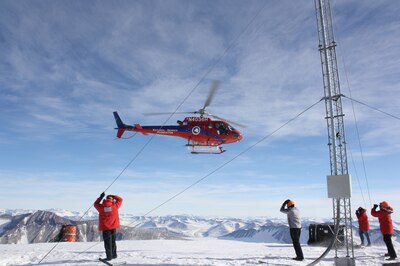By Susan A Romano, 25th Air Force
PATRICK AIR FORCE BASE, Fla., Jan. 19, 2018 — With 24 hours
of daily sunlight in their favor, a team of seismic technicians traveled to
Antarctica at the southernmost point on Earth to conduct annual maintenance of
the equipment they use to monitor global nuclear treaties.
Six members of the Air Force Technical Applications Center
based here made the trek to Antarctica to troubleshoot and replace seismometers
that contribute to the International Monitoring System.
The team also conducted full inventories at the sites and
replaced generator starter batteries used to power the stations. The seismic
equipment is used to detect activity caused by naturally occurring events such
as earthquakes, volcanic eruptions or lightning strikes, as well as man-made
events such as mining activity or nuclear explosions.
Air Force Staff Sgt. Jeremy Hannah, a geophysical
maintenance supervisor, served as the team lead during the five weeks the team
was deployed. Hannah and his fellow seismic maintainers flew from the United
States to New Zealand, then on to McMurdo Station in Antarctica, a 14-plus hour
trek from one hemisphere to another, including flights aboard an Air Force C-17
and a Bell 212 helicopter.
Logistics, Research Hub
McMurdo Station is the logistics and research hub of the
U.S. Antarctic Program and is managed by the National Science Foundation. As
part of its global nuclear treaty monitoring mission, AFTAC analyzes seismic
data collected from the station and provides it to the U.S. National Data
Center.
The Antarctica site, located 1,200 miles north of the South
Pole in the McMurdo Dry Valleys near Lake Vanda, supports the International
Monitoring System as part of the Comprehensive Test Ban Treaty Organization,
and is one of thousands of sensors within AFTAC’s global network, the largest
in the Air Force.
A typical duty day for the team consisted of an early rise,
breakfast, field work, lunch, preventive maintenance requirements and dinner.
Then, a few hours of enjoying the beauty of the landscape. When the team is at
the station, they sleep in hardened facilities. In the field, they’re in
sleeping bags on the floor of the hybrid power station at Bull Pass or Mount
Newall.
Staying properly nourished in sub-zero temperatures is
critical to team safety and wellness. When they’re at McMurdo, they enjoy their
meals at the station’s cafeteria. When they’re in the field, however, they cook
their meals using a camping stove and crockpot. And while most would think the
frigid temperatures and austere conditions are the most challenging aspect of
their mission, one team member said his biggest hurdle was sunlight.
“Personally for me, having no real track or sense of time
was difficult to get used to,” said Air Force Senior Airman Richard Westra, a
geophysical maintenance supervisor. “Twenty-four hours of sunlight was a
blessing because we could accomplish so much work without worrying about
darkness, but it was also somewhat disconcerting not knowing if it was 10 a.m.
or 10 p.m.”
Antarctica: ‘Absolutely Breathtaking’
He added, “After a full day of work, though, it’s great to
be able to take a hike or walk around to see a place very few people in the
world get to experience. Every morning I’d get up and just look outside for
several minutes, taking it all in. It’s absolutely breathtaking, and the views
blow your mind each day.”
Of the six airmen who made the journey, four had never
visited the site before. Travel to AFTAC’s site requires airlift via
helicopter, which was one team member’s favorite part of the journey.
“It was so cool to fly over a partially-frozen sea, see
penguins and orcas and witness the scenery below in a helicopter, no less,”
said Air Force Senior Airman Andrew Pouncy, one of the first-time visitors. “It
was an opportunity of a lifetime, and I hope I’ll be able to make the trip
again.”
In addition to providing seismic information to senior U.S.
decision makers, the data from these sensors also help scientific and academic
communities at large.
“We closely coordinate with the NSF and the U.S. Antarctic
Program not only when we are deployed to the southern hemisphere, but also when
we are back home in Florida,” Hannah said. “This trip, we also worked with the
Berg Field Center, the place that outfits both ground and helo teams that work
near and around McMurdo. They are an invaluable resource for us.”
The team also serviced AFTAC’s solar generators and wind
turbines, better known as hybrid power stations.
“Maintaining our seismic equipment at Vanda is critical to
our treaty monitoring mission,” Hannah said. “Because of the weather and rugged
terrain, we have a small window of opportunity to perform the necessary
troubleshooting to ensure the data is transmitted to the NDC in support of the
International Monitoring System as part of the Comprehensive Test Ban Treaty
Organization. I’m really proud of the team and what they were able to
accomplish on this trip.”
The airmen are now authorized to wear the Antarctica Service
Medal on their uniforms.

No comments:
Post a Comment